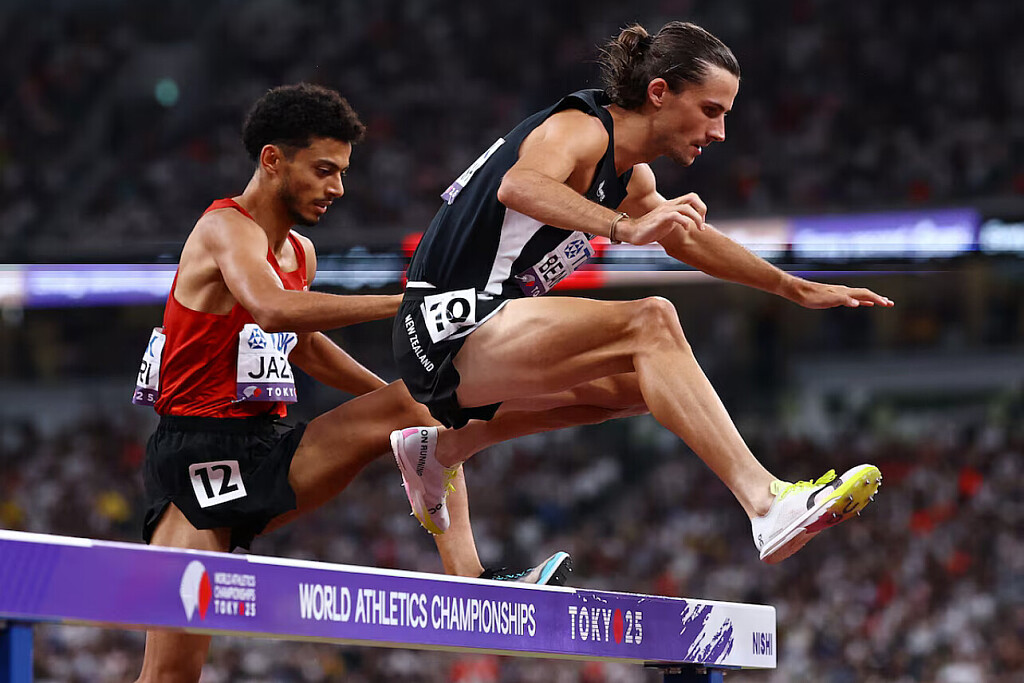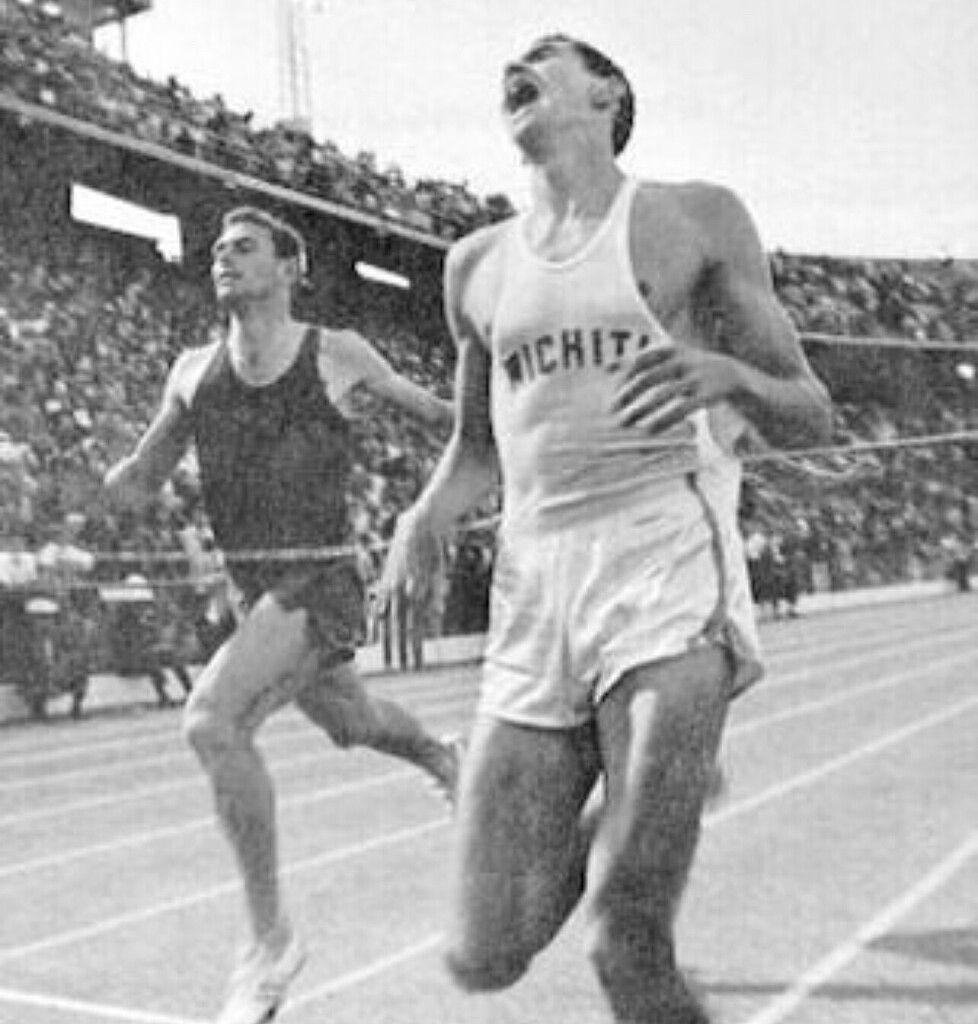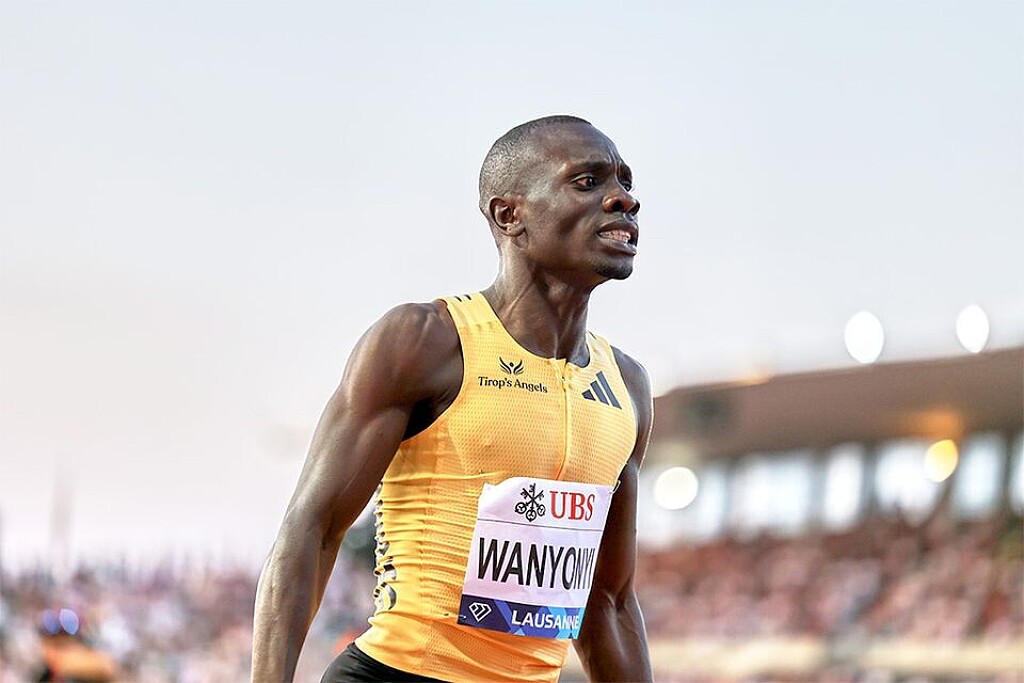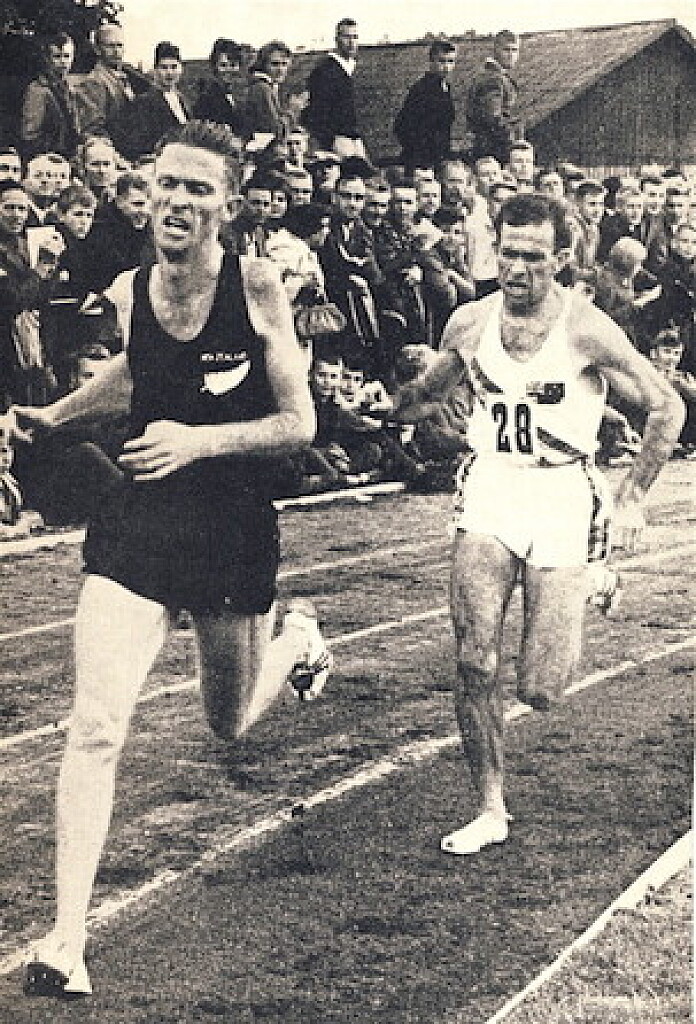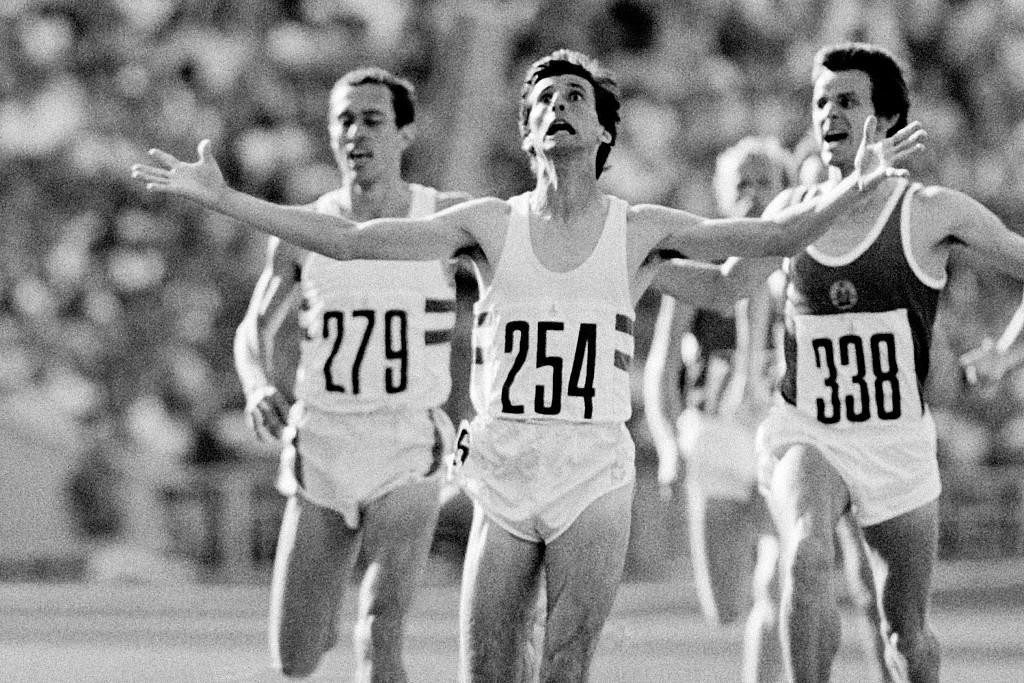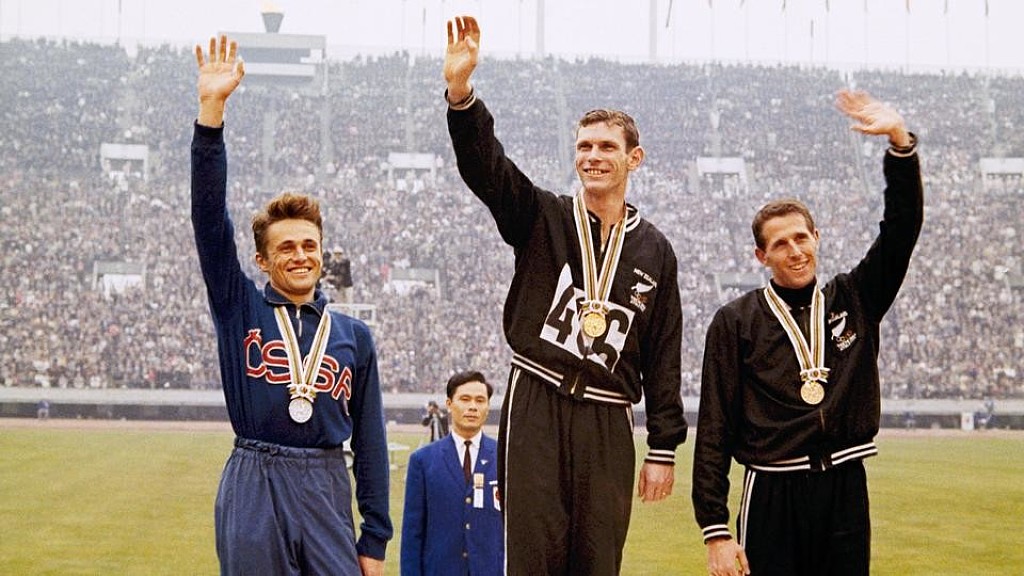Running News Daily
Running News Daily is edited by Bob Anderson. Send your news items to bob@mybestruns.com Advertising opportunities available. Train the Kenyan Way at KATA Kenya and Portugal owned and operated by Bob Anderson. Be sure to catch our movie A Long Run the movie KATA Running Camps and KATA Potato Farms - 31 now open in Kenya! https://kata.ke/
Index to Daily Posts · Sign Up For Updates · Run The World Feed
Articles tagged #Peter Snell
Today's Running News
Geordie Beamish Rises from a Fall to World Champion Glory in Tokyo
Tokyo, September 15, 2025 — New Zealand’s Geordie Beamish produced one of the most dramatic victories of the World Athletics Championships, storming to gold in the men’s 3000m steeplechase. His winning time of 8:33.88 edged Morocco’s reigning champion Soufiane El Bakkali by just 0.07 seconds, with 17-year-old Kenyan Edmund Serem taking bronze in 8:34.56 .
This is a breakthrough moment for New Zealand athletics: the nation’s first-ever outdoor World Championships track gold .
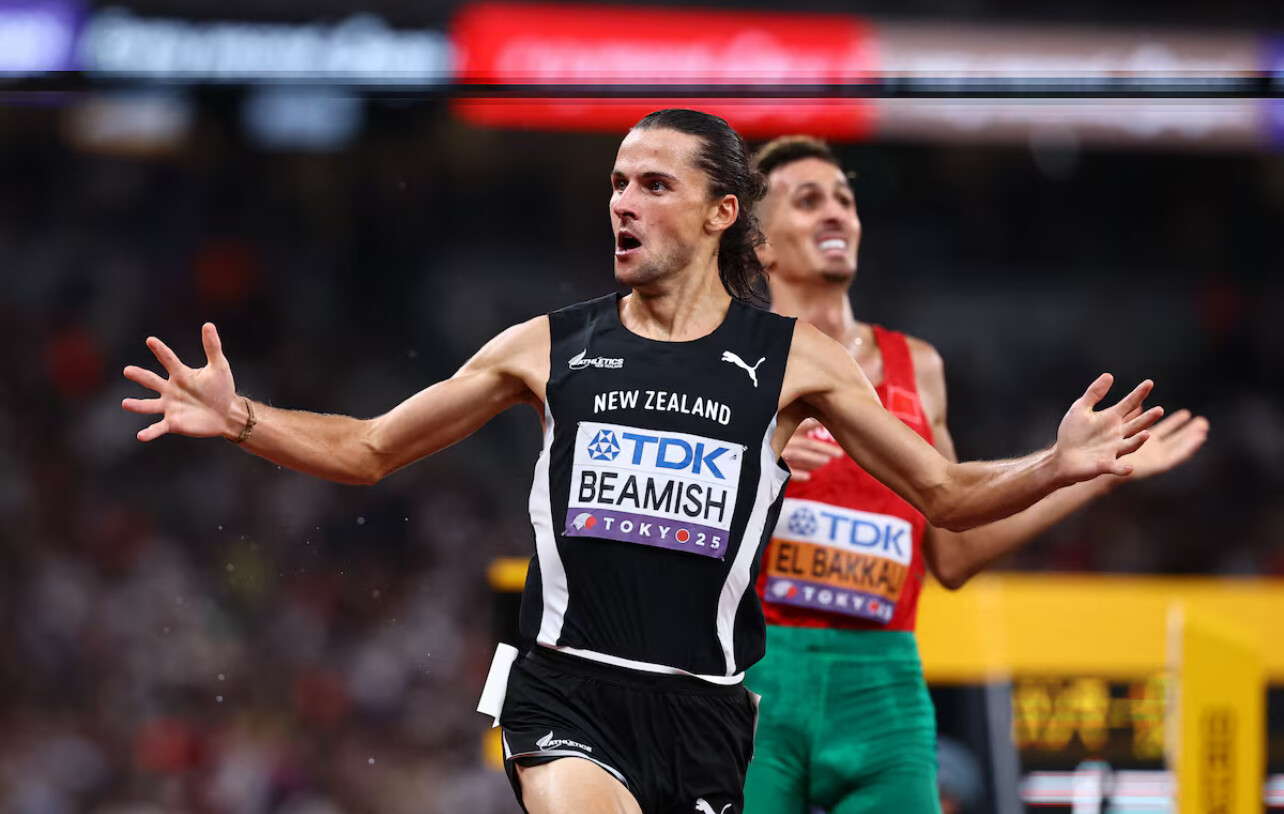
A Tactical Race Decided at the Line
The steeplechase final unfolded at a controlled pace, leaving the medals to be decided in the closing laps. El Bakkali, a two-time Olympic and world champion, looked ready to add another title. But Beamish, renowned for his devastating kick, stayed composed.

On the last lap, he surged through the field, matching El Bakkali stride for stride. Off the final water jump, Beamish unleashed one last burst of speed. In a thrilling lean at the line, he dethroned one of the event’s greats.
A fall and a spike in the heats
Beamish’s victory was even more remarkable considering his rough path to the final. In his qualifying heat, he fell heavily and was stepped on in the face, yet managed to get up and finish second to advance .
That resilience set the tone for his gold-medal run.
Who Is Geordie Beamish?
• Born: October 24, 1996, in Hastings, New Zealand
• Club: On Athletics Club (based in Boulder, Colorado)
• Coach: Dathan Ritzenhein
• Specialties: 1500m through 5000m, and now the steeplechase
• Career highlights:
• 2024 World Indoor Champion in the 1500m (Glasgow)
• Oceania record holder in the 3000m steeplechase (8:09.64, Paris, 2024)
• Fifth in the 2023 World Championships steeplechase final
Beamish’s late move to the steeplechase has transformed his career, turning him from a versatile miler into a global champion.
This was a big upset
Beamish’s Tokyo win not only toppled El Bakkali’s reign but also put New Zealand back on the map of world middle-distance running. For a nation that once celebrated icons like Peter Snell and John Walker, this is a new chapter in the sport’s history.
With the 2028 Los Angeles Olympics on the horizon , Beamish has proven he has the strength, resilience, and tactical brilliance to contend for more global medals.
by Boris Baron
Login to leave a comment
Eric Giacoletto: The Curator Preserving the Soul of Track and Field
In the fast-moving world of social media, few people are doing more to preserve the rich history of athletics than Eric Giacoletto. From his home in Albertville, France, Eric has become one of the most passionate archivists of the sport—sharing rare photos, insightful commentary, and forgotten moments that continue to inspire athletes and fans across the globe.
Though not a former elite runner himself, Eric’s knowledge runs deep, and his posts serve as daily reminders of what makes our sport timeless. He documents both legends and lesser-known heroes, giving context, names, and reverence to each moment he shares. His work has captured the attention of many—including My Best Runs founder Bob Anderson.
“What Eric is doing is important,” says Bob. “He’s preserving history—moments and athletes that might otherwise be forgotten. His posts are reminders of the beauty, pain, and glory of running.”
Just this past week, Eric posted dozens of compelling images from the golden eras of track and field. From that treasure trove, Bob Anderson selected eight photos he found particularly inspiring. Each tells a story—of courage, character, and the timeless spirit of competition.
Here are the eight photos Bob selected from Eric’s posts this past week:
Photo 1
Jim Ryun and Peter Snell – A Finish for the Ages
Two legends of the mile—Jim Ryun of Wichita and New Zealand’s Peter Snell—captured in one of the most dramatic finishes in middle-distance history. Ryun’s expression of anguish and Snell’s graceful stride speak volumes about what it takes to be world-class. An image that defines grit, shared by Eric earlier this week.
Photo 2
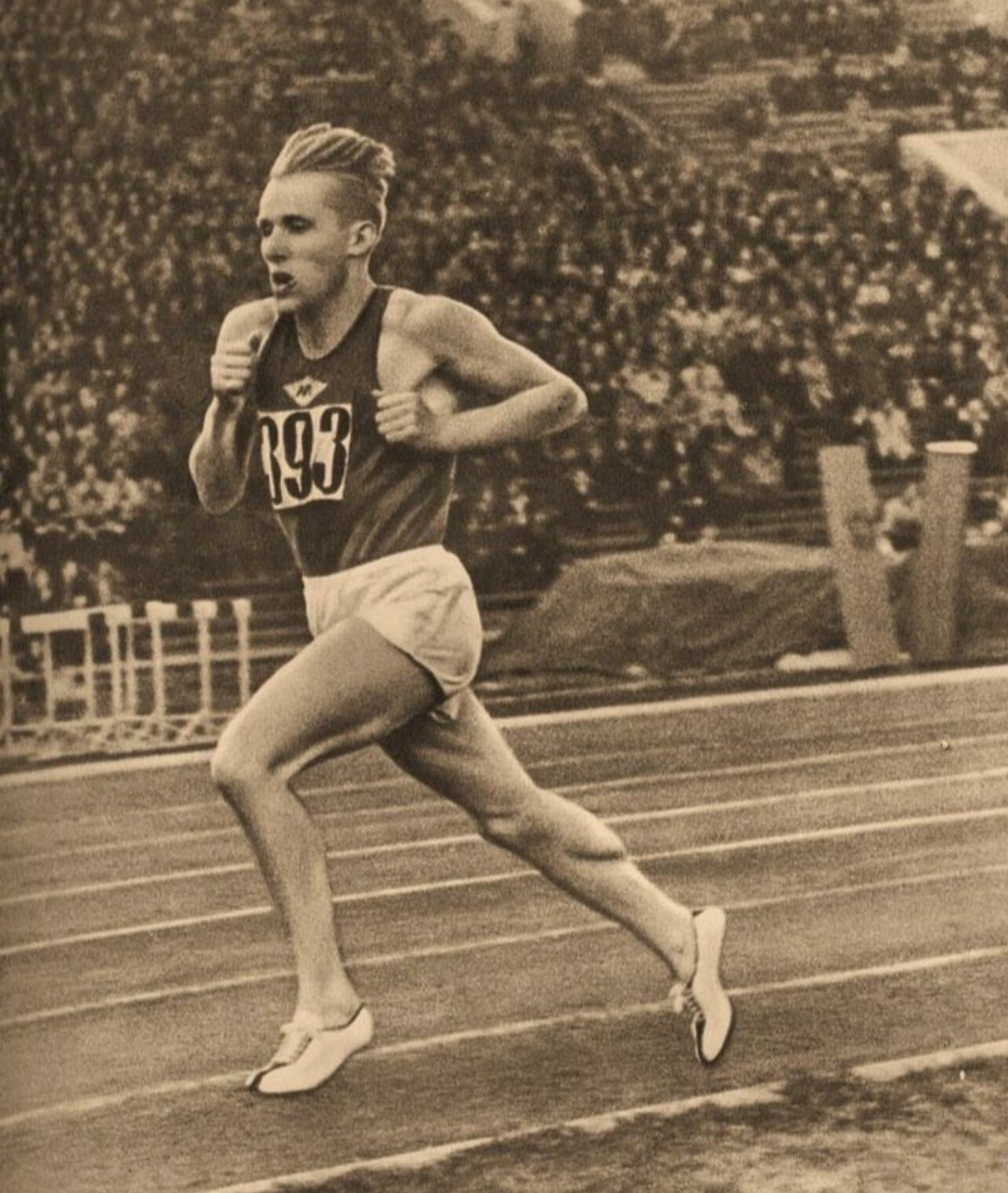
Vladimir Kuts – Soviet Powerhouse in Full Flight
Sprinting down the track with trademark aggression, Vladimir Kuts dominated the 1956 Olympics in Melbourne, winning both the 5,000m and 10,000m. Eric’s photo selection highlights Kuts’ unmistakable form and ferocity—a reminder of Eastern Bloc distance dominance during the Cold War era.
Photo 3
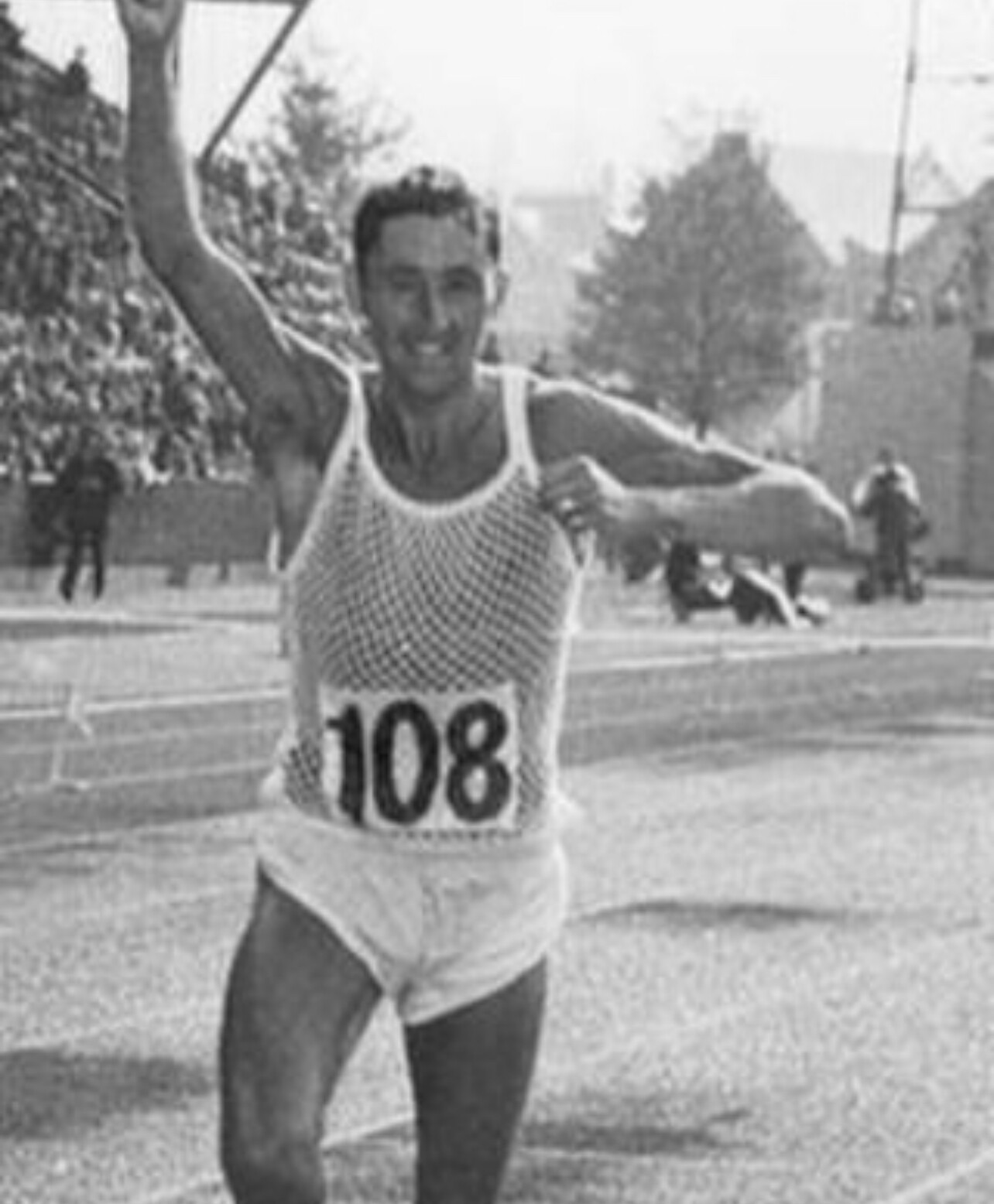
Ron Hill – 1970 Commonwealth Games, Edinburgh
Ron Hill, the pioneering English marathoner, crosses the line in his signature mesh singlet. By 2014, he had logged 159,106 lifetime miles—running at least one mile every day for 50 years. A legendary streak by a man who redefined commitment to the sport.
Photo 4
Steve Prefontaine in His Element
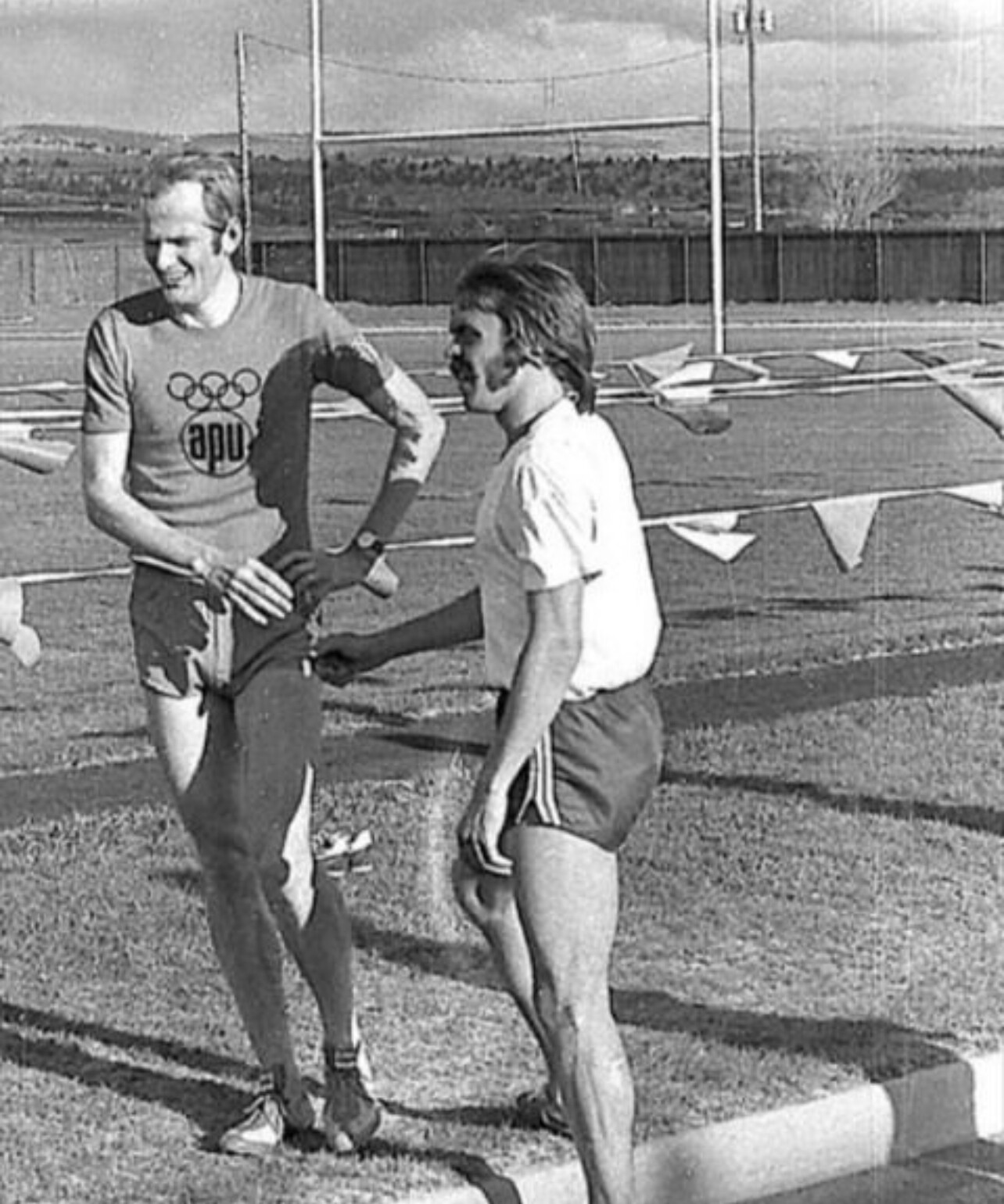
A candid photo of “Pre” during a training session, captured in conversation and camaraderie. Prefontaine’s fearless front-running style and outspoken personality made him a symbol of competitive fire. This relaxed moment shows the human side of a distance icon.
Photo 5
Herb Elliott – Training on the Dunes of Portsea
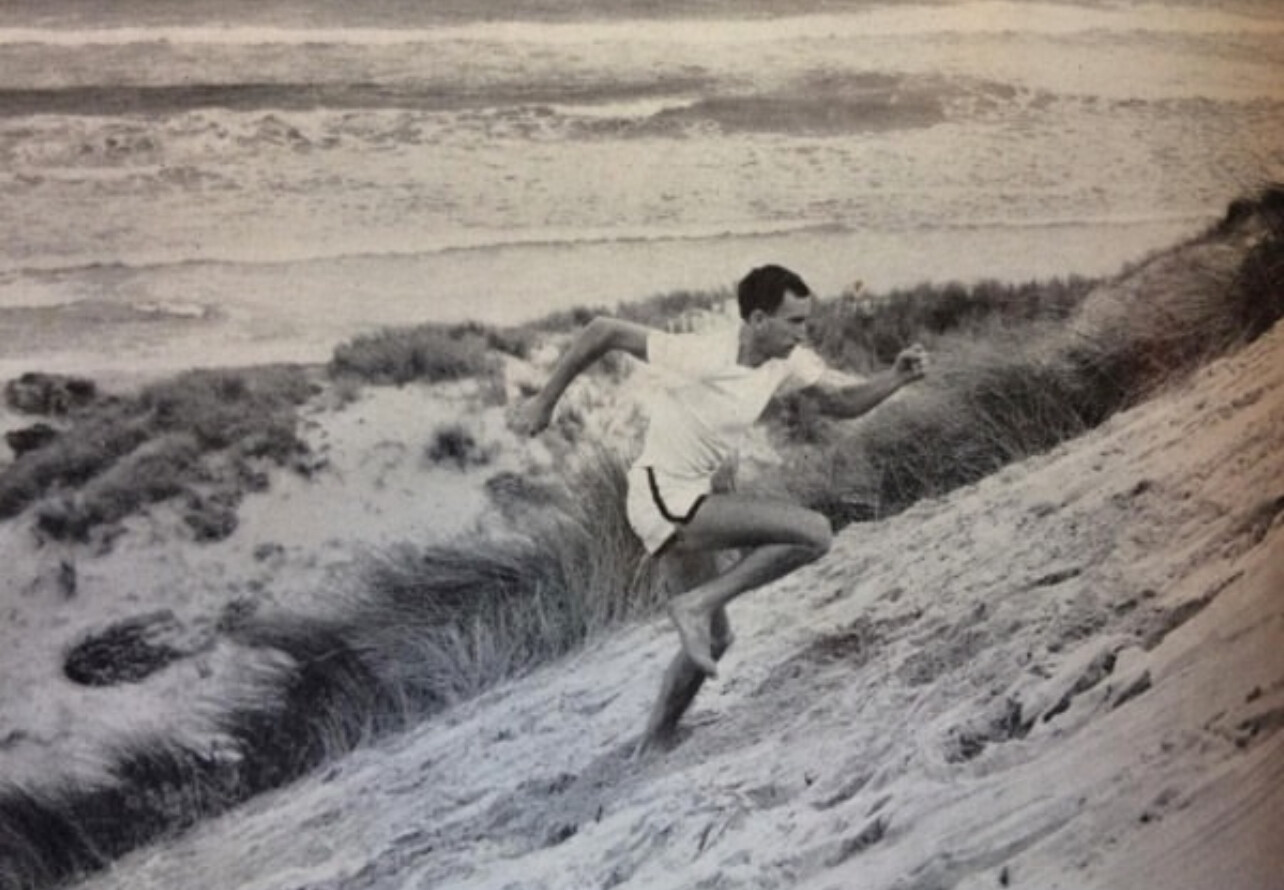
A powerful shot of Australian great Herb Elliott charging barefoot up the coastal sand dunes, guided by coach Percy Cerutty’s naturalist philosophy. Elliott never lost a 1500m or mile race in his career, and this photo shows the raw work behind that undefeated record.
Photo 6
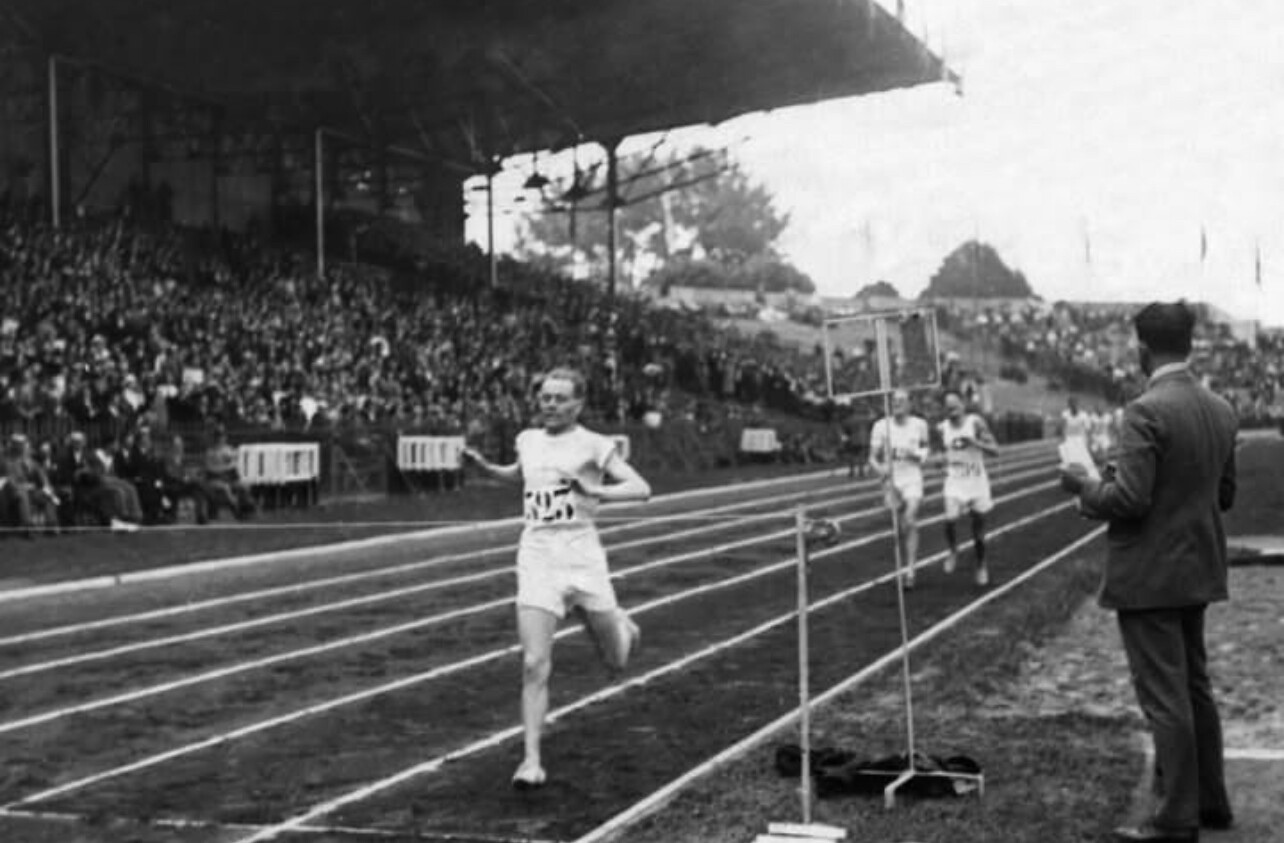
Paavo Nurmi – Double Gold in One Afternoon
Paris, July 10, 1924: Paavo Nurmi wins the 1500m, then returns just hours later to take gold again in the 5000m. This photo shows him well ahead of the field, delivering one of the most jaw-dropping performances in Olympic distance running history.
Photo 7
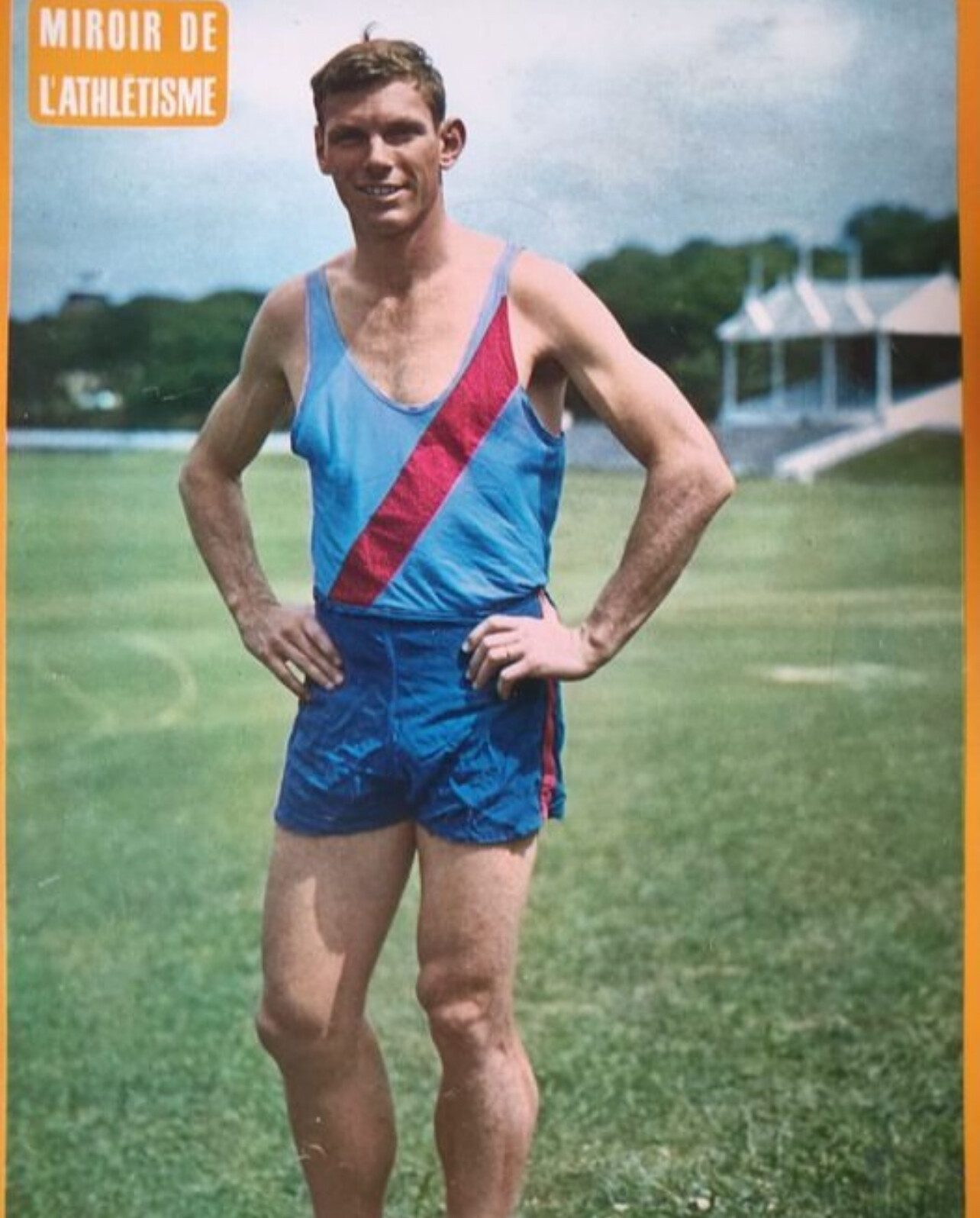
Peter Snell – Power and Poise in Color
A rare color image of New Zealand’s Peter Snell, one of the greatest middle-distance runners of all time. Winner of three Olympic gold medals, Snell combined strength with speed in a way few ever have. Eric’s post brings his iconic stature to life in full color.
Photo 8
Bill Rodgers – Boston Breakaway, 1975
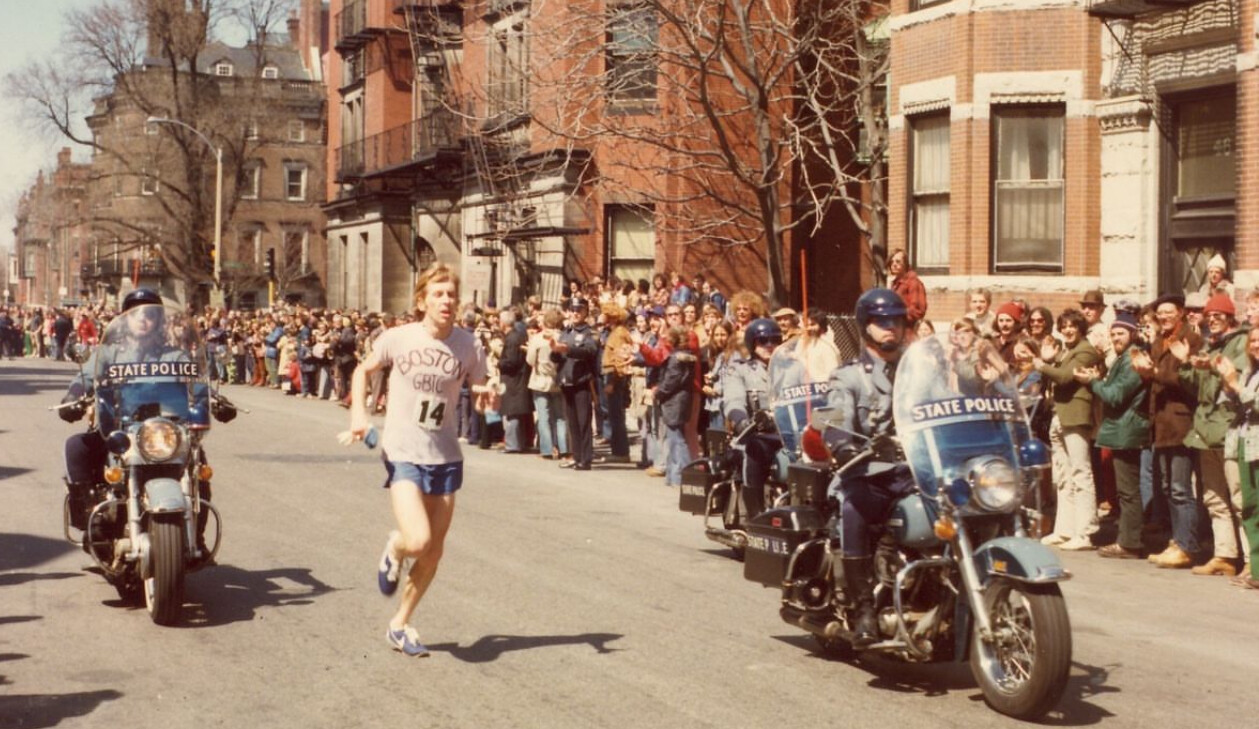
Captured mid-stride during his victory at the 1975 Boston Marathon, Bill Rodgers pulls away under the escort of state police motorcycles. His win that year—2:09:55—was part of a dominant streak that made him a U.S. marathon legend. A city, and a sport, in full celebration.
Honoring the Archivist
Eric’s posts on Facebook and Instagram (@ericgiacoletto) continue to spark meaningful conversations among athletes, historians, and lifelong fans. Whether he’s unearthing a forgotten race photo or celebrating an athlete’s legacy, Eric is doing more than documenting—he’s inspiring.
If you enjoyed this feature, and with Eric’s permission, we’d love to post more regularly here at My Best Runs. Let us know what you think—we’re always looking to spotlight the people and moments that keep the spirit of our sport alive.
by Boris Baron and Bob Anderson
Login to leave a comment
Celebrating Tom Farrell: An American Middle-Distance Icon Turns 81
Yesterday marked the 81st birthday of Tom Farrell, one of America’s most celebrated middle-distance runners and a bronze medalist in the 800 meters at the 1968 Olympics in Mexico City. Farrell’s performance in that final was nothing short of remarkable, as he clocked a lifetime best of 1:45.4 to secure his place on the podium in one of the most competitive eras in the sport.
Farrell’s legacy in middle-distance running extends beyond his Olympic medal. Four years earlier, at the Tokyo 1964 Olympics, Farrell finished fifth in the 800-meter final, establishing himself as a rising star on the global stage. Between Tokyo and Mexico City, he cemented his status as one of the world’s elite middle-distance runners.
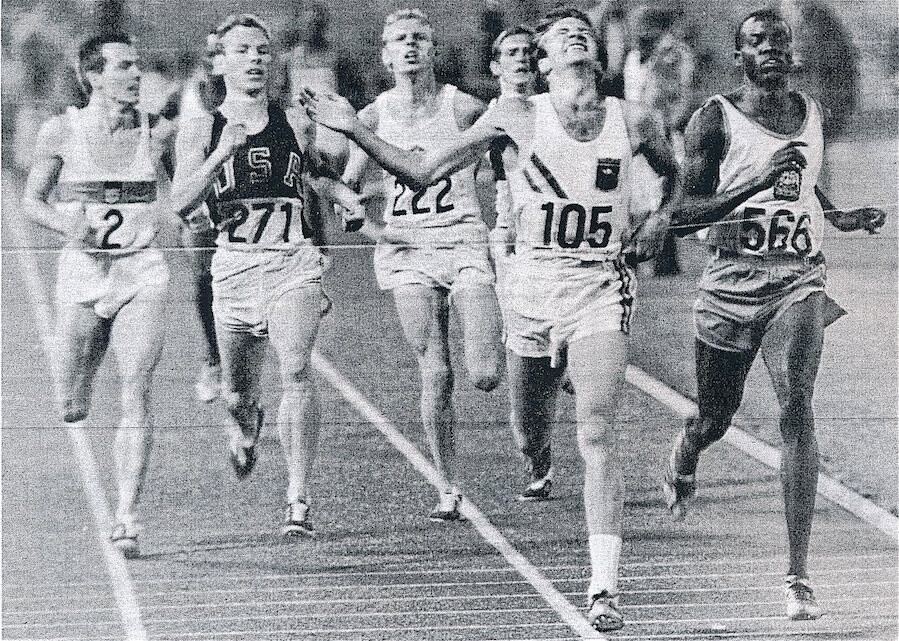
One of his most notable achievements came indoors, when Farrell broke the 800-meter indoor world record with a time of 1:49.0, previously held by the legendary Peter Snell. The record-breaking performance occurred during a race where Farrell defeated another formidable rival, Ted Crothers, further showcasing his dominance.
Despite his incredible talent and potential, Farrell’s athletic career came to an early end. After his success at the 1968 Olympics, at just 24 years old, he retired from competitive running to focus on his professional life outside of athletics. His decision highlights the challenges many athletes of that era faced, balancing the demands of sport with the need to secure a stable livelihood.
Farrell’s contributions to American middle-distance running remain a source of inspiration. His achievements during a golden era of track and field, characterized by intense rivalries and historic performances, continue to be celebrated by the running community.
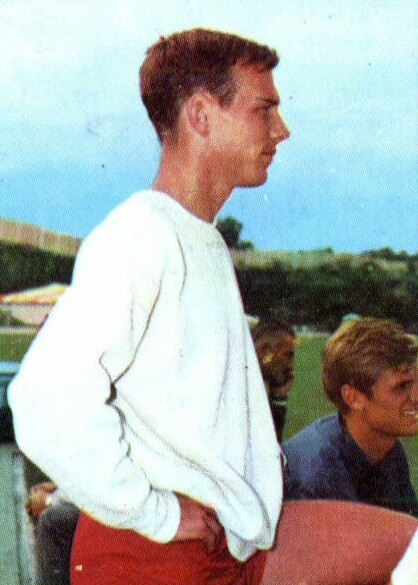
As we honor Tom Farrell on his 81st birthday, we remember not only his accomplishments on the track but also his enduring influence on the sport. Here’s to a remarkable athlete, a trailblazer in middle-distance running, and a legacy that still inspires athletes worldwide. Happy Birthday, Tom Farrell!
by Eric Giacoletto and Boris Baron
Login to leave a comment
Why David Rudisha believes Emmanuel Wanyonyi is destined to break his 800m world record
Wanyonyi got to within an eighth-hundredth of a second away from equalling David Rudisha's 12-year 800m world record at the Lausanne Diamond League classic on Thursday.
When David Rudisha tipped Emmanuel Wanyonyi as the athlete most likely to break his 12-year-old 800m world record during the Kenyan trials for the Olympic Games at Nyayo National Stadium last June, it wasn’t just a casual remark.
Rudisha’s prediction is now gathering weight, especially after Wanyonyi clocked a blistering 1:41.11 at the Lausanne Diamond League meet in Switzerland on Thursday.
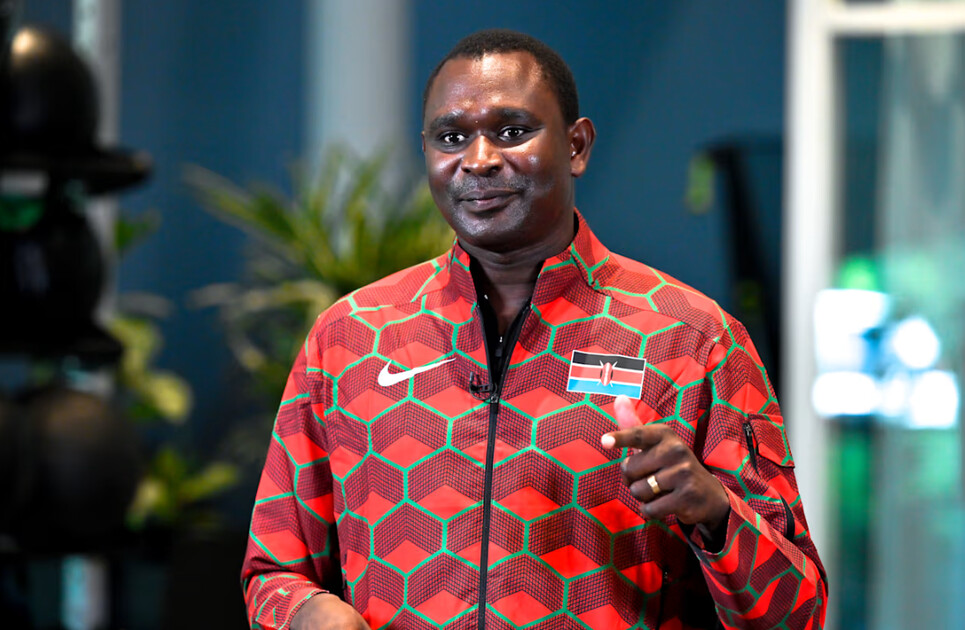
This time not only equaled Wilson Kipketer’s record but also placed Wanyonyi second on the all-time list, just eight hundredths of a second away from Rudisha’s world record of 1:40.91 set at the 2012 London Olympics.
“Wanyonyi is a young talented athlete. He has so much potential, and all he needs to do is fine-tune his craft, and this will see him push his time even lower,” Rudisha had told the media last June.
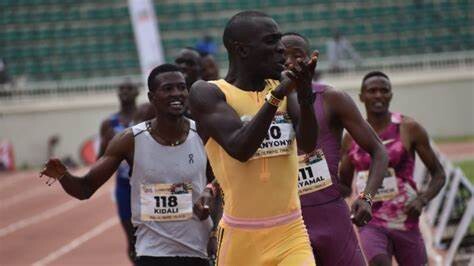
Rudisha, who knows a thing or two about world records, added, “He always shows his bravery and confidence whenever he steps on the track, and that has been the secret behind his success.
“World records are special. We are looking forward to seeing how the young generation is going to take up the challenge. Of course, there is a lot of innovation, and it improves performances. We believe that world records are there to be broken.”
Wanyonyi’s stunning performance in Lausanne has made him a force to be reckoned with in the world of athletics.
His time of 1:41.11 ties him with Kipketer and positions him as the most serious threat to Rudisha’s reign in the 800m. At just 20 years old, Wanyonyi’s rise to the top has been meteoric, and his determination to succeed mirrors that of Rudisha.
Rudisha himself had an illustrious career, beginning as a decathlete before switching to sprints and later focusing on the 800m in 2005. Just a year later, he won the 800m title at the World U20 Championships in Beijing, clocking 1:47.40.
In 2008, he claimed the African senior title in Addis Ababa with a time of 1:44.20. Then, on August 22, 2010, Rudisha set his first world record in Berlin, running 1:41.09 and breaking Kipketer’s 1997 mark.
Seven days later, he improved his record to 1:41.01 in Rieti. Rudisha continued his dominance by winning the world 800m title in Daegu in 2011, reclaiming it in Beijing in 2015, and becoming the first man since Peter Snell to retain the Olympic 800m title in Rio in 2016.
Now, Wanyonyi is carving out his own legacy. At 20, he became the youngest-ever Olympic 800m champion, leading a race of unprecedented depth in Paris.
He held off Canada’s Marco Arop, the reigning world champion, who briefly took the lead off the final turn before Wanyonyi surged back in the final steps. Arop finished with a North American record of 1:41.20 for silver, while Algeria’s Djamel Sedjati claimed bronze in 1:41.50.
Reflecting on his victory, Wanyonyi said, “It was going to be hard to defend as the only Kenyan in the final. I had a lot of pressure. I spoke to Rudisha yesterday, who told me I would win if I employed my tactics. I decided to run the way he did in London. If I had run a slow race, they would have beaten me.”
Although Wanyonyi didn’t quite match Rudisha’s record, he is keen on having another go at it when the Diamond League moves to Silesia, Poland, this Sunday.
While he has remained modest about his world-record ambitions, saying, “Maybe, but not now,” the Diamond League offers the perfect stage for him to make history. The Wavelight technology, which has been instrumental in helping athletes maintain pace, will also be in use, providing Wanyonyi with every opportunity to push the boundaries.
Wanyonyi is no stranger to breaking records. At 19, he shattered the previous one-mile (1,600m) record of 3:56.13 set by American Hobbs Kessler at the World Road Running Championships in Riga, Latvia, last year.
With Rudisha as his role model and mentor, Wanyonyi is poised to continue his upward trajectory and possibly eclipse the mark set by the man he so deeply admires.
As the athletics world watches, the question on everyone’s mind is not if, but when, Emmanuel Wanyonyi will break the 800m world record. And when that day comes, it will be the culmination of a journey inspired by greatness and driven by the relentless pursuit of excellence.
by Mark Kinyanjui
Login to leave a comment
Olympic 5,000-Meter Champion Murray Halberg Dies at 89
Murray Halberg, gold medalist in one of the most dramatic distance races in Olympic history and a four-time world-record holder, died in Auckland, New Zealand, on November 30. He was 89 years old.
Halberg achieved victory in the 1960 Olympic 5,000 meters with a decisive surprise attack at three laps to go. The feat is remembered as one of the great tactical triumphs in the history of world-class distance racing. He also showed the sheer speed necessary to run world records at 2 miles (twice), 3 miles, and in the 4 x 1-mile relay for the New Zealand team. He was the first New Zealander to break 4:00 for the mile.
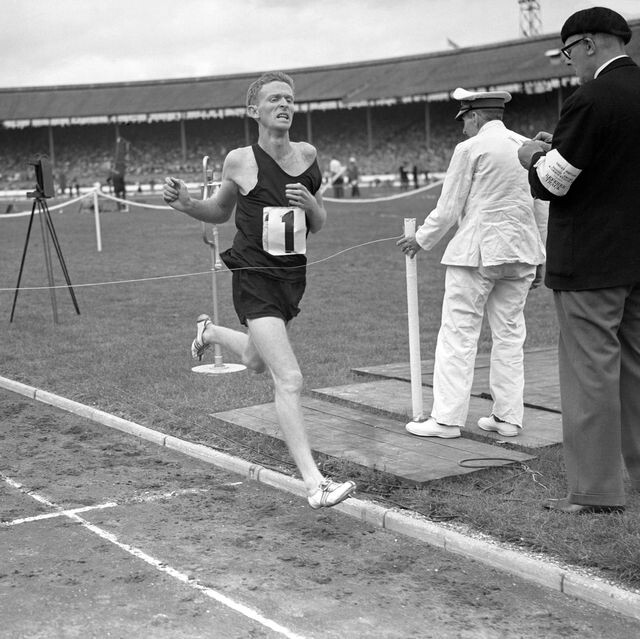
Sir Murray Halberg became a runner after a rugby injury at age 17 left him with a disabled left arm, and he linked with coach Arthur Lydiard after disappointment in the 1956 Olympic 1500 meters. He was the first runner to attain world stardom under Lydiard’s guidance.
His first major success was winning the 3-mile title in the 1958 Commonwealth Games. His Olympic win at Rome in 1960 came less than an hour after another Lydiard athlete, Peter Snell, won the 800 meters. The manner of both victories made Lydiard famous, and put New Zealand on the map of world distance running. Both showed the world the combination of pace and endurance attained through Lydiard’s structured high-mileage training. Halberg also finished fifth in the 10,000 meters at the Rome Olympics.
He made successful tours of the American indoors circuit, breaking the world indoor record for 2 miles (8:34.4) in 1961. He claimed wryly that his withered left arm was an advantage on the tight bends of indoors racing.
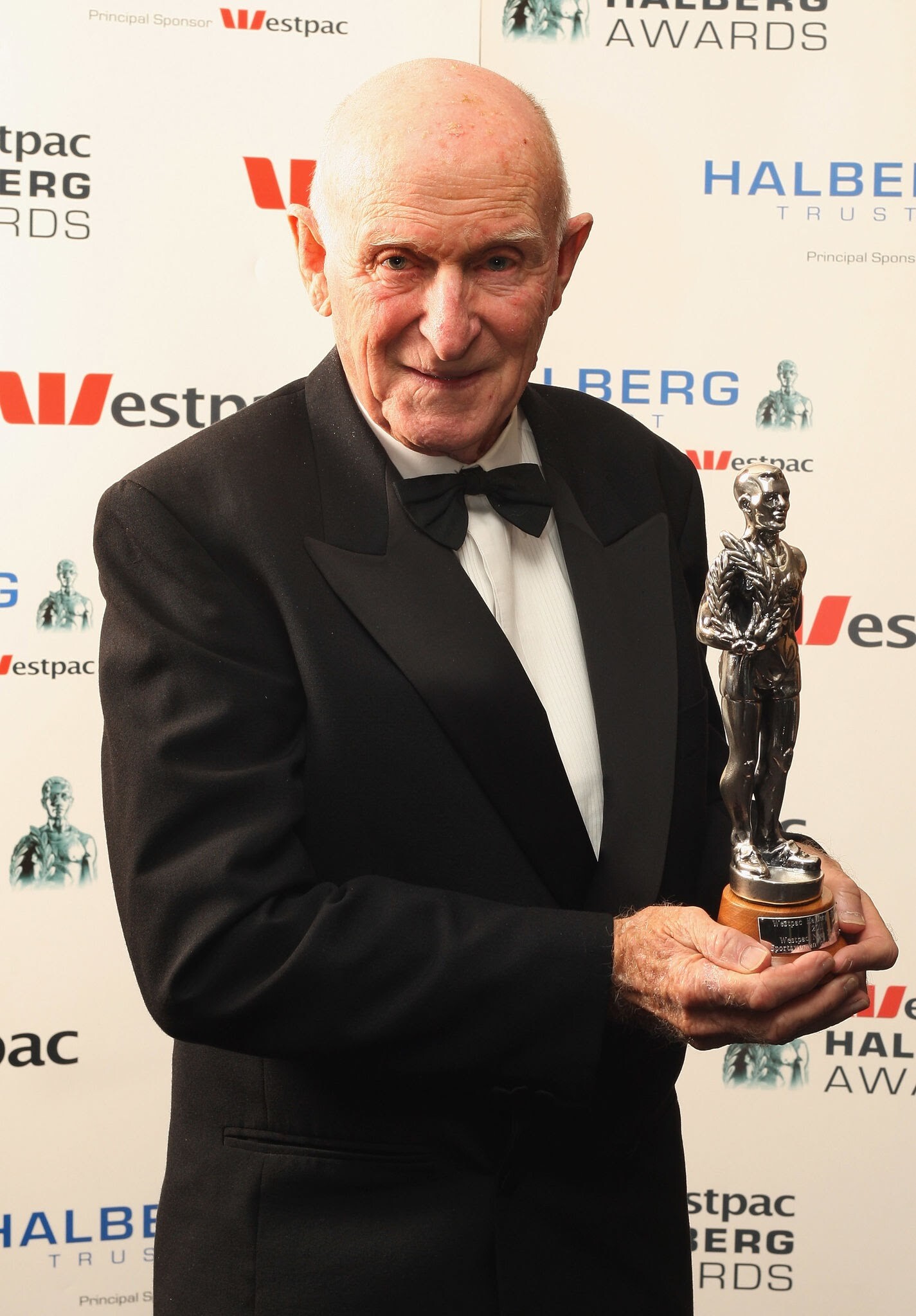
Halberg went on to repeat as Commonwealth 3-mile champion in 1962, defeating one of the strongest fields ever, with Ron Clarke, Bruce Kidd, Bruce Tulloh, Albie Thomas, Derek Ibbotson, and Kip Keino behind him. By that time he held the world record for 2 miles (8:30.0) and 3 miles (13:10.0). Athletes as great as 1960 Olympic 1500-meter champion Herb Elliott, Kidd, and Tulloh regarded Halberg as their most feared, competitive, and resilient opponent. He was world top-ranked at 3 miles/5,000 meters every year from 1960 to 1963, but at the 1964 Olympics he was affected by Tokyo’s polluted air, and finished seventh in the 10,000 won by Billy Mills.
Halberg gave his post-competition life to charitable work, creating the Murray Halberg Trust for Crippled Children in 1963, which became the Halberg Foundation, and hosted the annual New Zealand Sports Awards, known as the Halberg Awards. He received a knighthood for services to sport and child welfare, the first New Zealand athlete to receive the honor.
Halberg is the subject of A Clean Pair of Heels: The Murray Halberg Story by Murray Halberg and Garth Gilmour, and has in-depth profiles in The Lonely Breed, by Ron Clarke and Norman Harris and When Running Made History, by Roger Robinson.
by Runner’World
Login to leave a comment
Five high school boys have combined to break the four-minute barrier seven times in 2022 and no one has enjoyed it more than Jim Ryun
Jim Ryun was the first high school boy to break the four-minute barrier in the mile as a Kansas 17-year-old in 1964 and went on to a legendary track and field career that included three Olympic appearances in the 1,500m, a silver medal in the 1968 Mexico City Olympics, and numerous American and world records.
Ryun’s name always surfaces when a high schooler dips under 4 minutes in the mile. And in 2022, his name has been coming up a lot.
Ryun’s career was also in the spotlight earlier this month when he was one of 30 former college track and field athletes inducted into the inaugural class of the USTFCCCA’s Athlete Hall of Fame in conjunction with the NCAA Championships in Eugene, Ore.
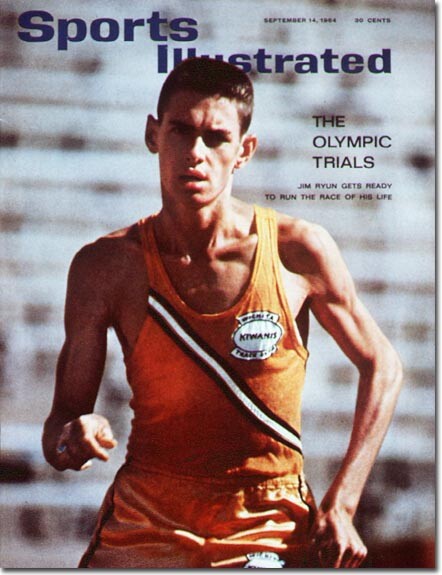
The original 4-minute high school barrier breaker celebrates the resurgence of American high school distance running and says for too long runners were held back in fear of what would happen if they ran under 4 minutes for the mile.
“I think they realize it’s not a barrier that can’t be broken, it’s more of a matter that if you break it,” Ryun said, “will you go on from there, which you can because we’re seeing more and more of them that are doing that.
“It’s not the barrier that it once was, should never have been there. For a long time, there were three of us. Myself, Marty Liquori and Tim Danielson. We were the only (sub) 4-minute milers from high school for years and I think it was the result of people being afraid of that, and coaches saying if you run too fast, too soon you’ll never make it very far.”
Growing up, Ryun often wondered if he would ever be successful in an athletic endeavor. He tried basketball and football and was cut from his church baseball team. At a high school assembly, Bob Timmons, the school’s track and field and cross country coach, encouraged students to run on his cross country team in the fall.
Ryun had never run more than one lap around a track before joining the cross country team, but in one season at Wichita East High School, he went from the last runner on the third-string team to a sixth-place finish at the Kansas state meet.
“Running was so new to me, I didn’t know who the heroes were,” Ryun recalled. “In fact, my first thought was I wanted to be a baseball, football, basketball player. Running, what’s that? So, it took a while. The first book Coach Timmons gave to me was about Emil Zatopek, the great Olympian, so I read that, and it began helping me understand about the sport.”
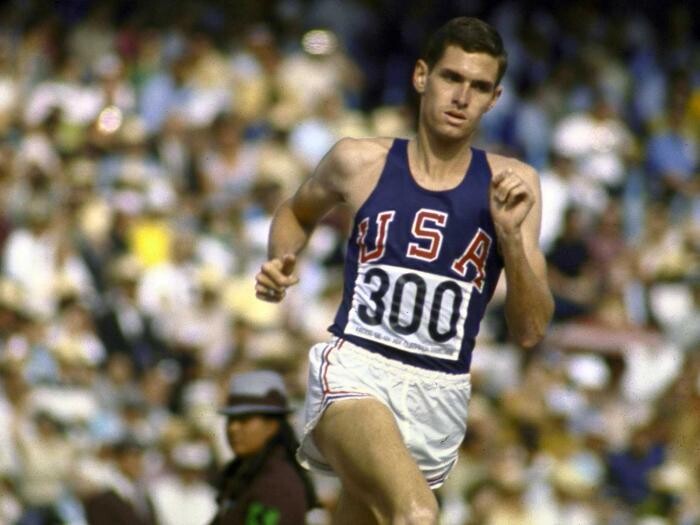
Ryun said Timmons was convinced he could be the first high school runner to break 4 minutes in the mile. That came true on June 5, 1964, when Ryun ran 3 minutes, 59.0 seconds to finish eighth at the Compton Invitational in Los Angeles.
“The goal originally was my coach’s because I was the kid that got cut from the church baseball team, didn’t have great talent and when I started running, I was looking for direction,” Ryun said. "And he began basically teaching me about goals, how to reach goals, and gave me workouts to get there. The night that I ran 4 minutes, 3:59.0, I didn’t sleep that night (before) because I realized that it was his goal.
“But my thought was, what happens if I take ownership, ownership being there’s certain things you as an athlete know you could do like maybe a little extra weightlifting, better eating. It was a transformational moment, because I mean when you finish eighth in a race and become the first kid to run under 4 minutes, that has to change your life – and it did.”
Ryun’s running career took off from there. He made the 1964 U.S. Olympic team in the 1,500m that went to Tokyo and was the last U.S. high school men’s track and field athlete to make the U.S. Olympic team until teenager Erriyon Knighton qualified for the 2020 Tokyo Olympics in the 200m and finished fourth there.
As a high school senior, Ryun broke 4 minutes four more times. His time of 3:58.3 at the 1965 Kansas state meet was the first time 4 minutes was broken in a high school-only meet. On June 4, 1965, Ryun returned to the Compton Relays, the site of his first sub-4-minute mile and ran 3:56.8. A little over three weeks later, he ran 3:55.3 at the U.S. AAU Championships in San Diego and beat New Zealand’s Peter Snell, the 1964 Olympic champion in the 800m and 1,500m.
Ryun, who would stay close to home and attend Kansas University after graduating from high school in 1965, roomed with a former Jayhawks great, Billy Mills, during U.S. training camps leading up to the 1964 Olympics. In Tokyo, Mills stunned the world by becoming the only U.S. athlete to ever win the Olympic 10,000m.
In 1966, Tim Danielson became the second American high schooler to break 4 minutes when he ran 3:59.4. A year later, Marty Liquori ran 3:59.8 to become the third high schooler under 4 minutes.
Ryun and Liquori had illustrious careers after high school, particularly Ryun. At age 19 in 1966, Ryun set two world records, first in the 800m (1:44.9), and then the mile (3:51.3). He was the NCAA indoor mile champion for Kansas in 1967, 1968 and 1969, and the 1967 outdoor NCAA mile champion. In 1967, he set a 1,500m world record of 3:33.1 that stood for seven years.
That same year, he lowered his mile world record to 3:51.1., a mark that stood for almost eight years. Ryun was the last American man to hold the mile world record. He still holds American junior records for the mile (3:51.3) and 2-mile (8:25.1), and his 800m American junior record of 1:44.9 stood for exactly 50 years.
In 2003, ESPN.com ranked Ryun as the greatest U.S. high school athlete of the 20th century, ahead of Tiger Woods, LeBron James, Lew Alcindor (now Kareem Abdul-Jabbar), Wilt Chamberlain, Marion Jones, and others.
After Ryun, Danielson, and Liquori, the 4-minute mile wasn’t broken by a prep athlete again for more than 32 years until Alan Webb ran 3:59.86 at the New Balance Games in New York on Jan. 20, 2001. Sensing something special in Webb, the promoters of the Prefontaine Classic in Eugene, Ore., invited him to run in the Bowerman Mile, the signature event of the meet that has since become a Diamond League event, on May 27, 2001.
Morocco’s Hicham El Guerrouj, still the world record-holder in the 1,500m and mile, won the event in 3:49.92, followed by Kevin Sullivan of Canada and Bernard Lagat, then of Kenya, who later ran for the U.S. They helped pull Webb to a fifth-place finish in 3:53.43, breaking Ryun’s 36-year-old high school record.
“I thought he would. I just didn’t know how much he would break it by," Ryun said. “It was one of those moments in time where he had run well, but he needed somebody to help him get over that finish line, just as I did running under 4 minutes for the first time. You need someone to help set the pace. You can relax a little bit, and he was able to take advantage of that.
“So, there was no real surprise to me. The biggest surprise was that there weren’t more high school boys running under 4 minutes.”
It would be another 10 years before a high schooler would break 4 minutes in the mile. In 2015, Matthew Maton and Grant Fisher, now the U.S. record-holder in the men’s 10,000m, both ran 3:59.38 about one month apart. In 2016, two runners broke 4 minutes, including Drew Hunter, who did it twice in a 15-day span in February indoors, both times in New York.
The 4-minute barrier was broken by high schoolers once in 2017 and again in 2020 during the height of the COVID-19 pandemic. In 2021, Hobbs Kessler ran the fastest high school mile since Webb when he ran 3:57.66 indoors. Kessler later that year broke Ryun’s 1,500m American junior record of 3:36.1 that stood for almost 55 years.
The lack of American high school runners breaking 4 minutes in the mile for decades might be a big reason why U.S. men haven’t enjoyed much Olympic or international success until recently. When Matthew Centrowitz won the men’s 1,500m at the 2016 Rio de Janeiro Olympics, he was the first American man to do so since 1908. At the same Olympics, Clayton Murphy won the bronze medal in the 800m, the first American man to medal in the event since 1992.
And when the World Athletics Championships are hosted on U.S. soil for the first time next month in Eugene, Ore., the defending 800m men’s champion is American Donavan Brazier.
“If you look back in history, you’d see there was a dominance maybe by a country for a time like Great Britain had all those great runners. America at one time was dominant in that area as well,” Ryun said. “So, I think it’s a matter of floating from place to place, and I think it comes down to motivation. How motivated are you?
“Over time you start realizing that motivation has to come down to you be willing to get up, run in all kinds of weather, race all over the world and let those talents be developed that God’s given you. So, it takes time. I think America can come back with dominance, but it also comes down to how motivated you are. I see the Kenyans as very motivated, and America can be just as motivated as you see with these new young runners that are developing quickly.”
That has proven to be the case this season. Seventeen high school runners have broken the 4-minute barrier, and 2022 has been the banner season for it so far with five runners breaking the mark seven times.
“I think a lot of coaches are seeing, too, that kids are just developing a lot faster doesn’t mean you’re going to burn out,” Ryun said. “It means you’ve got great opportunities. Will you decide to keep it going and, in my case, will you take ownership? The coach can only take you so far, but then you have to establish ownership.”
The owner of the fastest prep mile this year is Colin Sahlman, who ran 3:58.81 indoors in February, and, like Webb, was invited to the Bowerman Mile at the Prefontaine Classic. In a field that included 2020 Tokyo Olympic 1,500m gold medalist Jackob Ingebrigtsen, defending World Athletics Championships 1,500m gold medalist Timothy Cheruiyot, and defending 1,500m NCAA outdoor champion Cole Hocker, Sahlman finished 13th in 3:56.24. Of the 14 men who finished the race, seven set personal bests and seven set season bests, including Ingebrigtsen, whose time of 3:49.76 is the fastest in the world this year.
Sahlman’s time moved him to third on the all-time prep list behind Webb and Ryun. Sahlman, who is headed to Northern Arizona University for college, was part of a high school powerhouse at Newbury Park High in Southern California. In 2021, Newbury Park became the first high school team to have four runners break 4:10 for the mile in the same season.
“That mindset has really evolved and developed over these last three to four years,” Sahlman said in a March article in the Los Angeles Times. “It’s just like it’s transformed into something that we never thought was possible. Now we think anything’s possible.”
Gary Martin has also broken 4 minutes twice this year, running 3:57.98 on May 14 and 3:57.89 on June 2 in the Festival of Miles in St. Louis. At the Festival of Miles, Connor Burns ran 3:58.83 to become the first high school junior since Ryun to break 4 minutes. It was also the first time two prep runners broke 4 minutes in the same race.
Those two performances gave the Festival of Miles four prep runners who have broken 4 minutes. That’s where Fisher did in 2015, a feat repeated by Reed Brown a year later.
And one day after Martin and Burns broke 4 minutes, Rheinhardt Harrison ran 3:59.33 in Florida on June 3. On June 15, Simeon Birnbaum added to the list of sub-4 minute runners when he became the second high school junior this season to break the mark with a time of 3:59.51.
Will this high school running resurgence lead to greater U.S. success against international competition and major global championships? Only time will tell.
by Ashley Conklin (World Athletics)
Login to leave a comment
Sebastian Coe's monumental 800 meters
June 10, 1981 remains a red-letter day in the long history of 800m running, for it was in Florence late that night that Sebastian Coe lowered his own world record from 1:42.33 to 1:41.73. Every world record is special, marking as it does an advance on anything previously achieved, but Coe's run was extra-special. That time would not be bettered for 16 long years, itself a record in the annals of the men's 800m event.
When strongly-built Alberto Juantorena won the 1976 Olympic title in a world record 1:43.50 it was widely thought that here was the man to revolutionize two-lap running. And yet, for all his speed (44.26 400m) and power, the Cuban succeeded only in clipping another few hundredths off the record with 1:43.44 at the 1977 Universiade. Instead it was the slight figure of Coe who has gone down in history as the athlete who, like Germany's Rudolf Harbig in 1939 and New Zealand's Peter Snell in 1962, pushed back the frontiers of 800m performance.
It was in 1979 that Britain's Coe established himself as one of the all-time greats of middle distance running when in the space of 41 days he shattered three world records. He started with 1:42.33 in Oslo on July 5, and was as shocked as everyone else by his time. After clocking his fastest 400m of 46.87 at the AAA Championships he returned to Oslo for the star-studded Dubai Golden Mile on July 17. Despite being practically a novice at the distance with a best time of 3:57.67, he moved into the lead shortly before the three-quarter mark (2:53.4) and then proceeded to cover the final quarter in 55.6. He had run 3:48.95, again astonished when told he had broken New Zealander John Walker's world record of 3:49.4. As he related later: "When I looked back twice in the final straight it was fear, it was panic, not pain, that I was feeling. I certainly wasn't in the slightest distress at the finish."
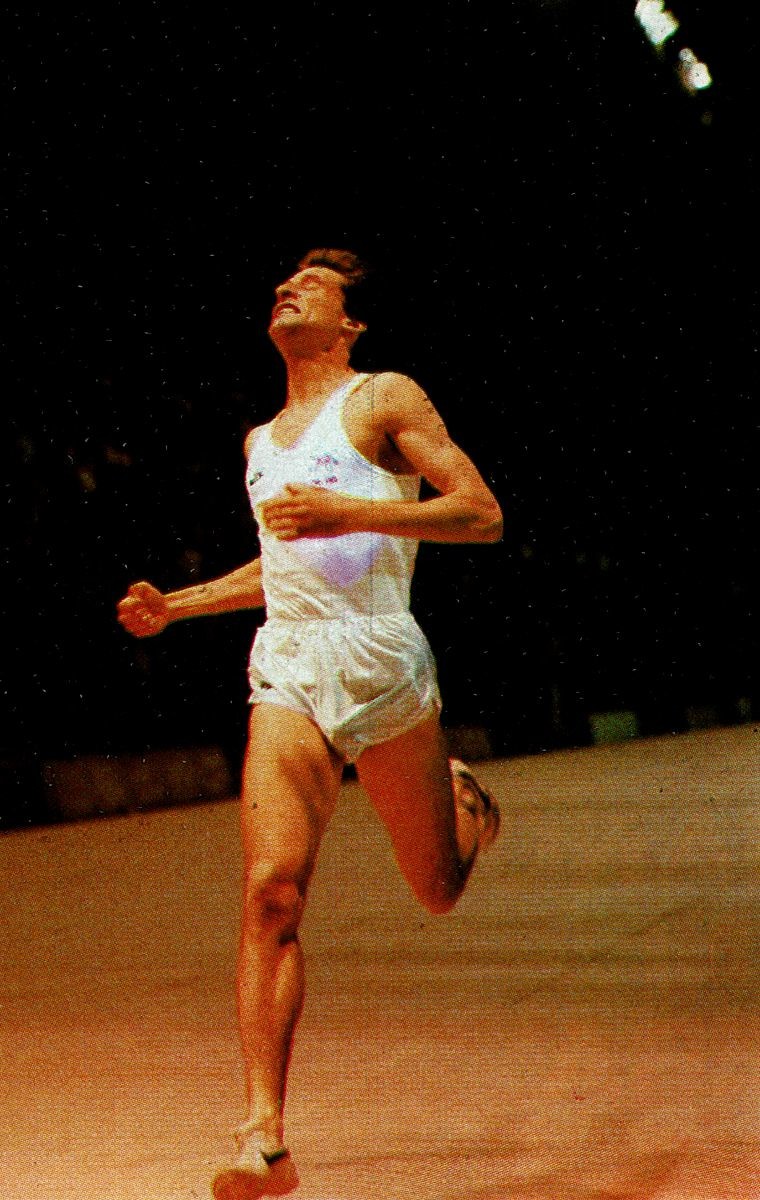
Record number three came about in Zurich on August 15. The target this time was the 3:32.16 1500m by Tanzania's Filbert Bayi. Elated by the knowledge that he had never been faster, having been timed at 45.5 for a 400m relay leg 10 days earlier, Coe shot off at a potentially suicidal pace by clinging to the pacemaker, sweeping through the opening 200m in 25.9 and 400m in 54.3. Before 800m (1:53.19) had been covered, Coe was on his own, nearly 20m ahead of the field. Instead of easing back on the third lap he covered that in 56.3 for 2:49.5 at 1200m and at the finish – almost five seconds clear – his time was a hard earned 3:32.03.
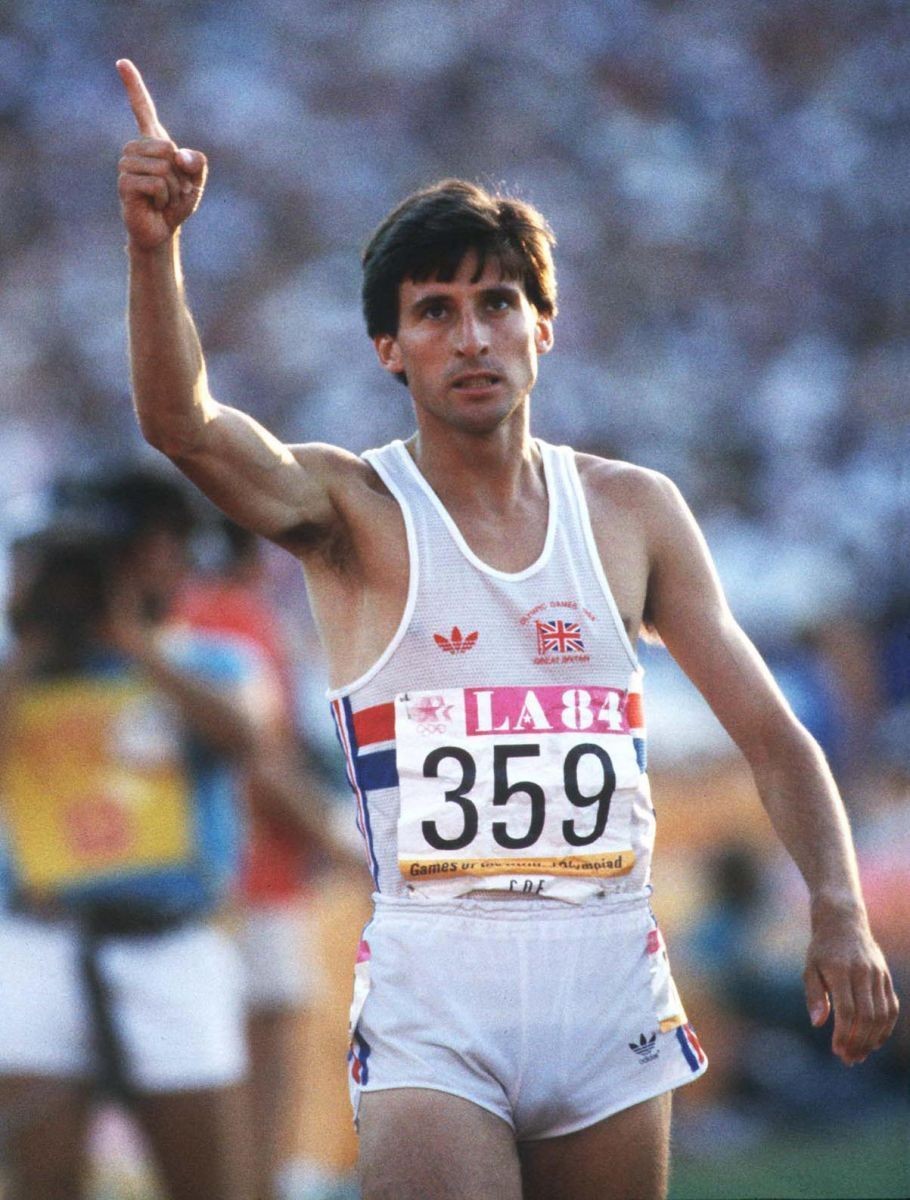
Coe's athletic immortality was sealed in 1980 when he triumphed in the Olympic 1500m in Moscow to make up for his 'disastrous' run in the 800m (a mere silver medal behind Steve Ovett) after adding to his portfolio of world records by covering 1000m in 2:13.40 in his first ever race at the distance.
And so to 1981. With no major title to aim for, the emphasis was on achieving spectacular 'one-off' performances. Asked how he had prepared during the winter, Coe replied: "My training mileage is slightly down but there's been more accent on speedwork. I'm going back to basics, trying to improve my 400m speed." That approach hadn't diminished his endurance, though, for he opened his indoor season by winning the UK 3000m title in a personal best of 7:55.2. Two weeks later he smashed the world indoor 800m record with 1:46.0. "I knew I was fit, but not that fit," he enthused.
A 46.9 400m and 46.3 relay leg on May 4 confirmed his speed was at a high level, and before his fateful appearance in Florence he won the Yorkshire county 800m title on May 17, in 1:46.5, an invitation 800m at Crystal Palace on June 3, in 1:44.06 followed two hours later with a 45.8 relay split from virtually a standing start, and as a final tune-up a 46.6 relay leg at Gateshead on 7 June. He traveled to Florence not expecting anything too special ... around 1:43/1:44.
His 800m race in Florence got under way after 11pm. Kenya's 19-year-old Billy Konchellah, then a 45.38 400m performer who would go on to become world 800m champion in 1987 and 1991, acted as pacemaker. In his slipstream Coe reached 200m in 24.5 and 400m in 49.7 and was perfectly set up for a super-fast time. Sensing Konchellah was about to flag, Coe forged ahead by 450m and after 200m splits of 24.5 and 25.2 he covered the next half-lap in a daring 25.3 for a remarkable 600m time of 1:15.0 – precisely 1:40 pace for the full distance. Inevitably he slowed towards the end but still managed a final 200m of a little under 26.7.
Coe's immediate post-race response: "I'm very happy about the result, but it was terrible waiting the 10 minutes for the official result. It's getting under 1:42 that is the great thing for me. It was as hard a race as I have run for a long time. In the last 30 meters I was beginning to tie up but apart from that there was no problem."
Coe went through that 1981 season undefeated, collecting further world records at 1000m (2:12.18) and mile (3:48.53 and 3:47.33). Other glittering performances would follow, notably a second Olympic 1500m triumph in 1984, but as a testimony to the quality of that 800m exploit in Florence note that even now, 40 years on, only two men have gone faster: David Rudisha of Kenya and Wilson Kipketer of Denmark.
by World Athletics
Login to leave a comment
Just 100 days to go for the Tokyo Olympic Games
With every major milestone comes that extra surge of excitement and anticipation for the rescheduled Olympic Games, for which there are now just 100 days to go.
On 23 July the spotlight will be on Tokyo's Olympic Stadium as it hosts the opening ceremony and one week later the world’s best track and field athletes will descend on the rebuilt venue of the 1964 Games as athletics action gets under way.

More than half a century ago, when Tokyo last hosted the Olympics, the stadium was the place where New Zealand’s Peter Snell tore up the track to achieve his 800m and 1500m double, Tamara Press of the Soviet Union took two titles in the shot put and discus, Britain’s Ann Packer sprang a surprise to win 800m gold in a world record and Bob Hayes equalled the world record to win the 100m.

Further history will be made at that site this summer and it will all start with the opening ceremony in 100 days’ time.
“We are so looking forward to seeing athletes from all over the world marching into the new stadium at the opening ceremony ... when the eyes of the world will be on this iconic symbol of the Tokyo 2020 Games,” said Tokyo 2020 CEO Toshiro Muto on completion of the stadium’s construction, which took 36 months at a cost of ¥157 billion ($US 1.4 billion).
The National Stadium, or ‘Kokuritsu kyÅgijÅ’, which will be known as the Olympic Stadium during the Tokyo Games, was officially completed in November 2019. Demolition of the 1964 Olympics venue had begun in 2015 to make way for the 68,000-seater created with sustainability in mind.
Designed by Japanese architect Kengo Kuma, the look of the stadium – a ‘living tree’ – is reminiscent of traditional Japanese temple design with wooden facades and greenery to blend with the nearby Meiji Jingu Gaien area. The multi-layered eaves are made of wood gathered from Japan's 47 prefectures, while more than 47,000 trees were planted within the stadium’s precinct.
Inside, 185 airflow-creating fans and mist-cooling systems will create cooler competition conditions and the three tiers of seating, which will not feature overseas spectators for the Games, is in earthy and green tones to mimic sunlight filtering through the trees, or in this case the roof, and on to the forest floor – the seating and Mondo track.
While there are just 100 days to go until the Games, athletics action is heading to the Olympic Stadium even sooner as it will host the second meeting in the 2021 World Athletics Continental Tour Gold series.
‘READY STEADY TOKYO – Athletics’ will take place on 9 May and for many of the athletes expected to compete, this meeting will provide their first look at the state-of-the-art facility.
Continental Tour Gold disciplines to be contested include the men’s 100m, 200m, 400m, 3000m steeplechase, 110m hurdles, 400m hurdles, high jump, pole vault, long jump and triple jump, while the women’s events are the 1500m, 3000m steeplechase, 100m hurdles, long jump and triple jump.
The meeting is part of the ‘READY STEADY TOKYO’ series of test events organized by Tokyo 2020 in the lead-up to the Games.
by World Athletics
Login to leave a comment
Tokyo 2020 Olympic Games
Fifty-six years after having organized the Olympic Games, the Japanese capital will be hosting a Summer edition for the second time, originally scheduled from July 24 to August 9, 2020, the games were postponed due to coronavirus outbreak, the postponed Tokyo Olympics will be held from July 23 to August 8 in 2021, according to the International Olympic Committee decision. ...
more...100 years ago Britain's Albert Hill completed a monumental middle distance double at the 1920 Olympic Games in Antwerp
It was 100 years ago, on 19 August, that Britain's Albert Hill completed a monumental middle distance double at the 1920 Olympic Games in Antwerp, the last man to achieve that distinction until New Zealand's Peter Snell in 1964. Yet it was the power of his arguments as much as the strength of his legs and lungs that enabled him to become an Olympic legend.
The British selection committee originally chose him only for the 800m after finishing second to the UK-based South African Bevil Rudd in the AAA 880 yards championship, but because he had not contested the mile Hill was omitted from the 1500m team. Hill had set his sights on going for an Olympic double and forcefully argued his case with Sir Harry Barclay, the influential AAA honorary secretary.

As he recalled: "The committee were opposed to my attempting the 800 and 1500m. But I was adamant on tackling the double and in the end Sir Harry bowed to my arguments. Most of the critics, too, were against my decision – the more so because I had been defeated by Bevil Rudd. Many considered Rudd as the greatest middle distance runner of that era. But when he beat me at Stamford Bridge my leg was still troubling me. Shortly afterwards, with the aid of a bandage above the ankle, it improved 100 per cent and I was determined to show the critics that I was not the has-been they thought I was."
Born on 24 March 1889, Hill had first made a name for himself as a cross country and long distance track runner, winning the AAA 4 miles title in 1910 aged 21, but after war service in France as a wireless operator with the Royal Flying Corps he was 30 by the time he was able to resume his athletics career. Coached by the legendary Sam Mussabini, he quickly made his mark at shorter distances by winning the AAA 880 yards and mile double in 1919, equalling the British record of 4:16.8 later in the year. A chain-smoking railway ticket collector who trained just twice a week, Hill was confident he could challenge the world's best at the Olympics the following year.
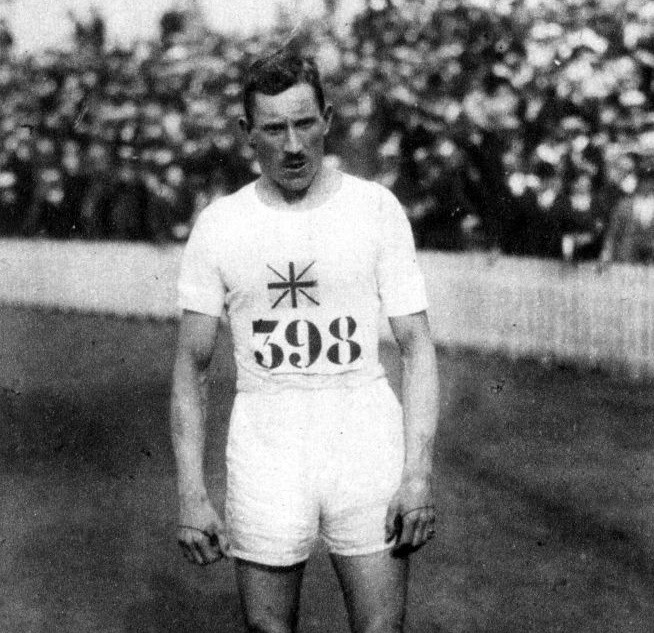
There was a shock in store when the composition of the 800m heats was revealed. As Hill wrote over 30 years later: "Our astonishment was great when we discovered that all the champions in the 800m were put in one heat! The Belgian authorities thought this the best thing to do, to give the other athletes a chance. This was their explanation, and nothing could be done about it, as the programmes had already been published. The first three in my heat, as it happened, took the first three places in the final, but in a different order."
Hill realised that Rudd, who would later win the 400m title, would be his most dangerous opponent and, entering the final straight, the South African led by three or four metres.
"Everyone expected an easy victory, but I was watching him closely, and noticed his arms beginning to come up high, and his body getting stiff. The stiffer his action became the more I forced myself to relax, arms down, body slightly forward. And turning on full speed, I caught up with him 20 yards out, going on to beat the American Earl Eby by a yard with Rudd third."
His time was a British record of 1:53.4 and he regarded that race as the most satisfying of his career in terms of judgement and tactics. In seventh place was the Dutchman Adriaan Paulen, who would serve as President of the IAAF from 1976 to 1981.
by World Athletics
Login to leave a comment
Peter Snell has died in Dallas. He was a three-time Olympic champion and world mile record-holder
Three-time Olympic champion and world mile record-holder Peter Snell has died in Dallas. He was aged 80.
Snell, who is regarded as one of the greatest middle-distance runners, won the 800 meters at the 1960 Rome Olympics aged 21, and the 800-1,500 double at the 1964 Tokyo Games.

He was the first man since 1920 to win the 800 and 1,500 at the same Olympics. No male athlete has done so since.
Snell also won two Commonwealth Games gold medals in the 880 yards and mile at Perth in 1962.
He twice held the mile world record, and held world records in the 800 meters, 880 yards, 1,000 meters, and the 4x1-mile relay.
Snell's death was confirmed by family friend and New Zealand sports historian Ron Palenski, who heads New Zealand's Sport Hall of Fame.
“It is very sad news, a grievous loss for New Zealand,” Palenski said. “In terms of track and field, he is probably the greatest athlete New Zealand has had.”
Snell was coached by Arthur Lydiard, an innovator who was regarded as one of the world’s finest coaches of middle and long distance athletes. Lydiard also coached Murray Halberg to win the 5,000 meters at Rome in 1960.
Snell was the best miler of his generation, at a time when the mile was the blue riband event of world athletics. He began immediately after Roger Bannister's epoch-making sub-four-minute mile and while the glow of that achievement still suffused the sport.
In his physique he was unlike milers of the time: Snell was strong and powerful — more like a 400-meter runner — and not like the mostly lithe athletes who vied for world supremacy over the mile.
His stride was so powerful he often scarred the tracks on which he ran, kicking up puffs of debris, especially on grass or cinder tracks. Lydiard's training — based on massive mileage mostly on the road rather than the track — gave him enormous stamina but he also had unusual speed.
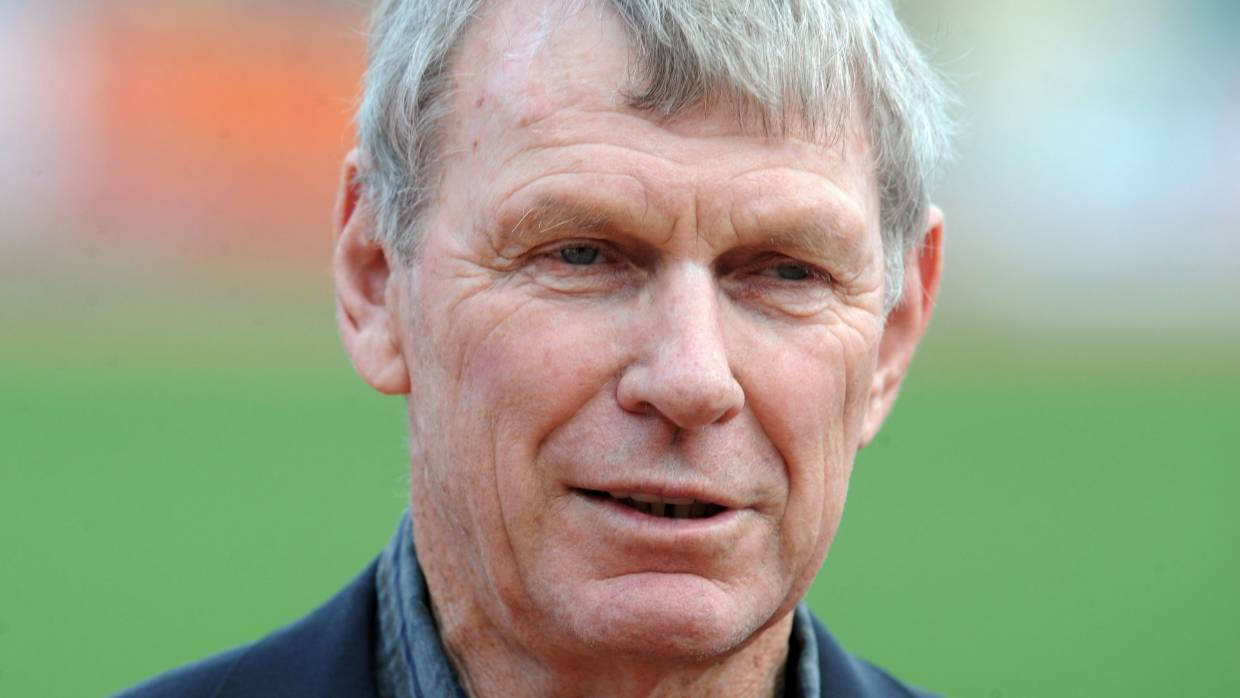
Snell's friend and training partner, Olympic marathon bronze medalist Barry Magee said “there will never be another New Zealand athlete like him.”
“He won three Olympic gold medals, two Commonwealth Games gold medals, and broke seven world records. He was the best-conditioned athlete of his time.”
Snell’s wife, Miki, said he died suddenly at his home in Dallas around noon on Thursday. He had been suffering from a heart ailment and required a pacemaker for several years.
Snell’s athletics career was relatively short. He retired in 1965 to pursue educational opportunities in the United States.
"Peter Snell was like a god to me," says MBR founder Bob Anderson. "I started running in February 1962 and Peter was my hero. I met him at one of our National Running Weeks in the early 80's and it was like meeting a rock star."
Snell graduated with a Bachelor of Science degree in human performance from the University of California, Davis, and later with a Ph.D. in exercise physiology from Washington State University.
He became a research fellow at the University of Texas Southwestern Medical Center in 1981, later becoming director of the university's Human Performance Center.
Snell was knighted by New Zealand in 2009. A statue in his honor stands at Cooks Gardens, Whanganui, near his birthplace of Opunake, where he broke the mile world record for the first time in 1962.
by Associated Press
Login to leave a comment
Former New Zealand Super Star Finds A Way To Compete
Olympians
Login to leave a comment


